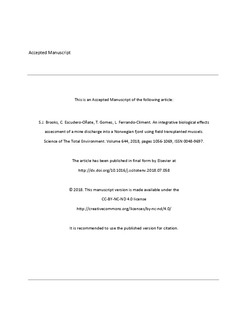| dc.contributor.author | Brooks, S.J. | |
| dc.contributor.author | Escudero-Oñate, C. | |
| dc.contributor.author | Gomes, T. | |
| dc.contributor.author | Ferrando-Climent, L. | |
| dc.date.accessioned | 2019-05-29T12:55:44Z | |
| dc.date.available | 2019-05-29T12:55:44Z | |
| dc.date.created | 2018-07-30T14:44:56Z | |
| dc.date.issued | 2018 | |
| dc.identifier.citation | Science of the Total Environment. 2018, 644, 1056-1069. | nb_NO |
| dc.identifier.issn | 0048-9697 | |
| dc.identifier.uri | http://hdl.handle.net/11250/2599460 | |
| dc.description | Embargo until 11 July 2020 | nb_NO |
| dc.description.abstract | The blue mussel (Mytilus sp.) has been used to assess the potential biological effects of the discharge effluent from the Omya Hustadmarmor mine, which releases its tailings into the Frænfjord near Molde, Norway. Chemical body burden and a suite of biological effects markers were measured in mussels positioned for 8 weeks at known distances from the discharge outlet. The biomarkers used included: condition index (CI); stress on stress (SoS); micronuclei formation (MN); acetylcholine esterase (AChE) inhibition, lipid peroxidation (LPO) and Neutral lipid (NL) accumulation. Methyl triethanol ammonium (MTA), a chemical marker for the esterquat based flotation chemical (FLOT2015), known to be used at the mine, was detected in mussels positioned 1500 m and 2000 m downstream from the discharge outlet. Overall the biological responses indicated an increased level of stress in mussels located closest to the discharge outlet. The same biomarkers (MN, SoS, NL) were responsible for the integrated biological response (IBR/n) of the two closest stations and indicates a response to a common point source. The integrated biological response index (IBR/n) reflected the expected level of exposure to the mine effluent, with the highest IBR/n calculated in mussels positioned closest to the discharge. Principal component analysis (PCA) also showed a clear separation between the mussel groups, with the most stressed mussels located closest to the mine tailing outlet. Although not one chemical factor could explain the increased stress on the mussels, highest metal (As, Co, Ni, Cd, Zn, Ag, Cu, Fe) and MTA concentrations were detected in the mussel group located closest to the mine discharge. | nb_NO |
| dc.language.iso | eng | nb_NO |
| dc.publisher | Elsevier | nb_NO |
| dc.rights | Attribution-NonCommercial-NoDerivatives 4.0 Internasjonal | * |
| dc.rights.uri | http://creativecommons.org/licenses/by-nc-nd/4.0/deed.no | * |
| dc.title | An integrative biological effects assessment of a mine discharge into a Norwegian fjord using field transplanted mussels | nb_NO |
| dc.type | Journal article | nb_NO |
| dc.type | Peer reviewed | nb_NO |
| dc.description.version | acceptedVersion | nb_NO |
| dc.rights.holder | © 2018 Elsevier | nb_NO |
| dc.source.pagenumber | 1056-1069 | nb_NO |
| dc.source.volume | 644 | nb_NO |
| dc.source.journal | Science of the Total Environment | nb_NO |
| dc.identifier.doi | 10.1016/j.scitotenv.2018.07.058 | |
| dc.identifier.cristin | 1598997 | |
| dc.relation.project | Norges forskningsråd: 236658 | nb_NO |
| cristin.unitcode | 7464,20,13,0 | |
| cristin.unitcode | 7464,30,21,0 | |
| cristin.unitname | Økotoksikologi | |
| cristin.unitname | Miljøkjemi | |
| cristin.ispublished | true | |
| cristin.fulltext | postprint | |
| cristin.qualitycode | 2 | |

